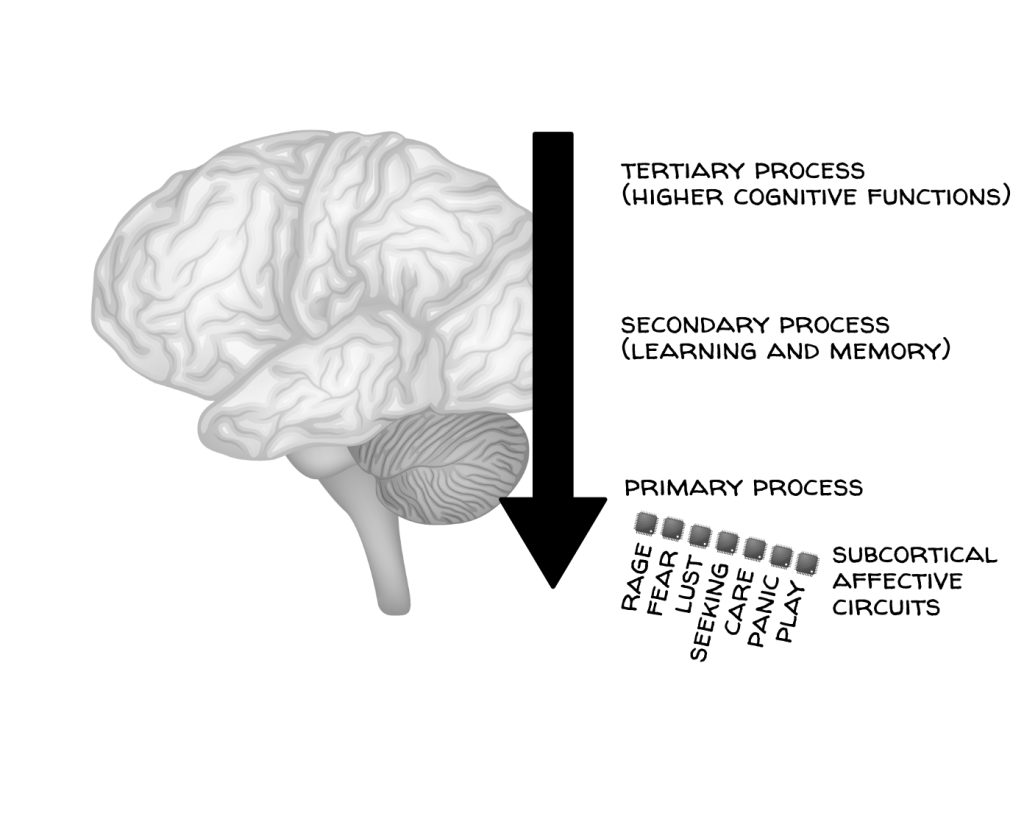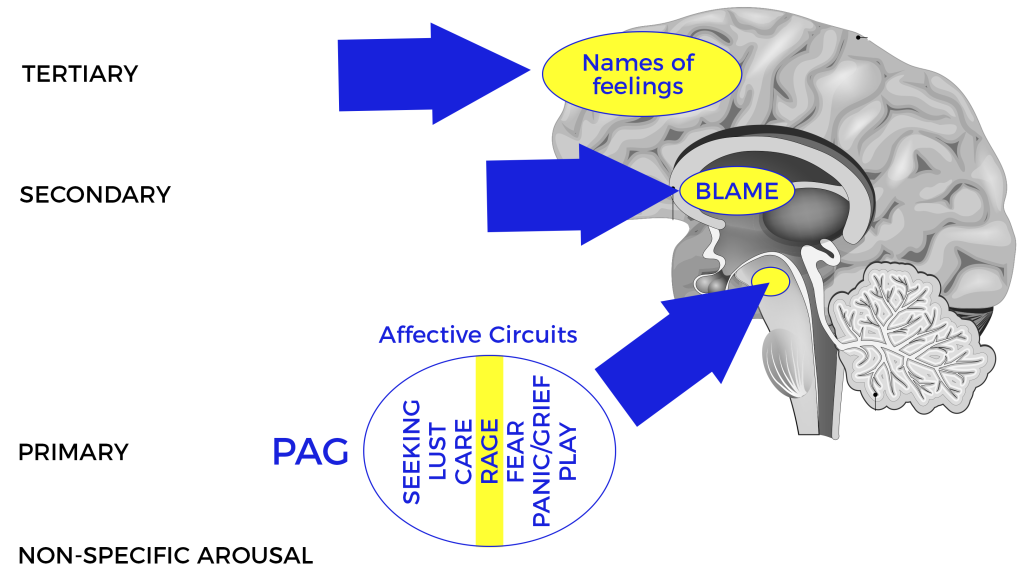In addition to top-down and bottom-up processes (see summary images below), emotions, and the feelings they produce can arise through various other mechanisms. And though I did my best to outline a whole bunch for you below — there are MANY other examples to be found. Moreover, these overlap and interconnect. The point of this post is to further bust the myth that your emotions only come from your thoughts.
Top Down Emotions: Thinking about something (“top of brain,” meaning the prefrontal cortex) triggers emotional responses in the mid-brain.

Bottom Up: The Example here is of an affective circuit being activated within the PAG (periaqueductal gray)…

It’s important again to note that emotions arise from the interaction of various biological, psychological, social, and spiritual factors. It’s all quite complex and for the most part what you yourself are experiencing, as well as what you are observing in another, would actually involve a combination of these factors 9and more!!), which interact dynamically to shape these emotional experiences. Never-the-less here are some examples:
- Hormones play a crucial role in modulating emotions. For instance, cortisol, known as the stress hormone, is associated with the body’s stress response and can influence emotional states. Similarly, neurotransmitters such as serotonin, dopamine, and norepinephrine are involved in regulating mood and emotions.
- Physiological States: In addition to the physiological states that I discuss all the time, physical states such as tiredness, hunger, and pain can significantly impact emotions. When you are fatigued, for example, you may be more prone to irritability or frustration. Similarly, hunger can affect your mood and make you more susceptible to negative emotions.
- Neurotransmitters are chemical messengers in the brain that facilitate communication between neurons. Imbalances or dysregulation of neurotransmitters can contribute to emotional disturbances. For example, low levels of serotonin are associated with depression, while imbalances in dopamine can impact motivation and reward-related emotions. As an example: Supplements and/or medications can have an effect on our neurotransmitters. You’ll see below that the microbiome also has an effect here. I am sure you can come up with many other examples, for instance…
- Genetics: Neurotransmitter imbalances can be a result of genetics, for example, variations in genes coding for serotonin receptors or transporters are associated with the risk of mood disorders like depression and anxiety.
Additionally, epigenetics refers to modifications in gene expression that occur without changes in the underlying DNA sequence. Epigenetic mechanisms, such as DNA methylation and histone modification, can influence how genes are turned on or off, and therefore impact emotional responses. Environmental factors, including stress, early-life experiences, diet, and lifestyle, can influence epigenetic modifications and shape emotional responses. Epigenetic changes can be stable and long-lasting, potentially affecting an individual’s emotional reactivity throughout their lifetime and even being passed on to future generations.
Gene-environment interactions also come into play, for example, environmental factors can modulate the expression of particular genes and influence whether or not the emotional disorder manifests. - Neural Circuits and Brain Systems: Emotions involve complex neural circuits and specific brain structures. The amygdala, prefrontal cortex, hippocampus, and insula are some of the brain regions involved in emotion processing. Disruptions, traumas (eg TBIs), and/or dysfunction in these areas can lead to emotional dysregulation. As one of many examples, toxic mold can wreak havoc on your brain.
Times of Hyperplasticity: How neurons talk to each other might change rather quickly if the brain enters into a hyperplastic state. This is how trauma encodings are installed in the brain. We also see stress-induced structural plasticity.
Neuroplasticity: For better or worse, we can play a part in shaping the landscape of our brains, and this in turn can affect our emotions.
Brain Systems: Even without getting to the point of a diagnosable disorder, we tend to see that different people use their different brain systems, well… differently. We could call this “typical” or “atypical.” If I had a “hot ACG” (more active than typical) I might find myself getting stuck on things (over focusing) and might be an excellent grudge-holder. - Cognitive Appraisal: Cognitive processes, such as perception (happens AFTER neuroception of course), interpretation, and appraisal of events, also influence emotions. How we perceive and evaluate situations can determine the emotional response they elicit. Cognitive biases, schemas, and beliefs shape our emotional experiences.
- Social and Environmental Factors: Emotions can be influenced by social interactions and environmental cues. Social support, relationships, cultural norms, and situational contexts can impact emotional experiences. For example, being in a supportive social environment can buffer against negative emotions, while social isolation can lead to feelings of loneliness and sadness.
- Gut-Brain Axis: The gut-brain axis refers to the bidirectional communication between the gut and the brain. The gut microbiota, which consists of trillions of microorganisms in the digestive system, can influence emotions and mental states. Emerging research suggests that imbalances in gut bacteria may contribute to mood disorders and emotional disturbances.
What About Trauma, Burnout, Etc…?
Physiological states like trauma and burnout can have a significant impact on emotions. Here’s how they come into play:
- Trauma: Traumatic experiences can have long-lasting effects on an individual’s emotional well-being. Trauma can disrupt the brain’s normal functioning and lead to alterations in the neural circuits involved in emotion regulation. It can result in heightened emotional reactivity, hypervigilance, and difficulties in emotional regulation. Trauma-related emotions can be intense, intrusive, and may be triggered by reminders of the traumatic event. Individuals who have experienced trauma may also develop symptoms of post-traumatic stress disorder (PTSD), which can further impact their emotional state.
- Burnout: Burnout is a state of chronic physical and emotional exhaustion that is often related to prolonged work-related stress. When individuals experience burnout, their physiological systems, such as the endocrine system and the autonomic nervous system, can be dysregulated. This can lead to imbalances in stress hormones (e.g., cortisol) and disruptions in the body’s stress response. As a result, individuals may experience emotional symptoms such as depersonalization, cynicism, and a reduced sense of accomplishment. Burnout can also lead to feelings of sadness, irritability, and a general decrease in overall well-being.
Both trauma and burnout can influence emotions through multiple pathways, including:
- Dysregulation of the stress response: Trauma and burnout can lead to chronic activation of the stress response, resulting in increased levels of stress hormones. This can contribute to feelings of anxiety, fear, and emotional dysregulation.
- Altered brain functioning: Trauma and chronic stress can impact the structure and function of brain regions involved in emotion processing and regulation, such as the amygdala, prefrontal cortex, and hippocampus. These alterations can lead to difficulties in emotion regulation, heightened emotional reactivity, and decreased emotional resilience.
- Disrupted sleep patterns: Trauma and burnout can disrupt sleep patterns, leading to insufficient or poor-quality sleep. Sleep disturbances can affect emotional well-being, contributing to mood swings, irritability, and difficulties in managing emotions.
- Negative cognitive patterns: Trauma and burnout can influence cognitive processes, leading to negative thinking patterns, self-criticism, and distorted perceptions of oneself and the world. These cognitive factors can perpetuate negative emotions and make it challenging to regulate emotions effectively.
- Interpersonal difficulties: Trauma and burnout can impact social relationships and lead to difficulties in interpersonal interactions. These challenges can further contribute to feelings of isolation, loneliness, and emotional distress.
What About that “Etc…”?
Besides trauma and burnout, there are several other factors and conditions that can have significant impacts on emotions and overall well-being. Some of these include:
- Chronic Stress: Prolonged exposure to chronic stress, whether it’s due to work, relationships, financial difficulties, or other factors, can have detrimental effects on emotions. Chronic stress can dysregulate the body’s stress response system, leading to increased levels of stress hormones and negatively impacting mood, cognitive functioning, and overall emotional well-being.
- Mental Health Disorders: Various mental health disorders, such as depression, anxiety disorders, bipolar disorder, and personality disorders, can significantly affect emotions. These conditions often involve disturbances in mood regulation, emotional processing, and the overall functioning of neural circuits related to emotions.
- Chronic Illness: Living with chronic illnesses, such as autoimmune disorders, chronic pain conditions, or neurological disorders, can impact emotions. Chronic physical symptoms, limitations in daily functioning, and the emotional toll of managing a long-term health condition can contribute to increased stress, anxiety, and feelings of frustration or sadness.
- Substance Abuse: Substance abuse and addiction can profoundly impact emotional well-being. The misuse of drugs or alcohol can alter brain chemistry, disrupt emotional regulation systems, and contribute to mood disorders or emotional instability.
- Sleep Disorders: Sleep disorders, such as insomnia, sleep apnea, or narcolepsy, can disrupt sleep patterns and impair the restorative function of sleep. Sleep deprivation or poor-quality sleep can lead to irritability, mood swings, and difficulties in emotional regulation.
- Hormonal Changes: Fluctuations in hormonal levels, such as those experienced during puberty, pregnancy, menopause, or certain medical conditions, can influence emotions. Hormonal imbalances can contribute to mood swings, irritability, and affect emotional well-being.
- Nutritional Imbalances: Poor nutrition and dietary imbalances can impact emotional health. Deficiencies in essential nutrients, such as omega-3 fatty acids, B vitamins, or minerals like magnesium, can affect brain function and neurotransmitter regulation, which in turn can influence emotions.
- Social Isolation and Loneliness: Lack of social connection, social isolation, or feelings of loneliness can have detrimental effects on emotional well-being. Human beings are social creatures, and meaningful social interactions are crucial for emotional regulation and overall mental health.
